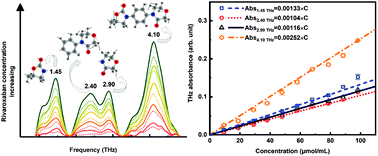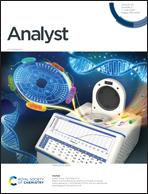Quantitative analysis of direct oral anticoagulant rivaroxaban by terahertz spectroscopy†
Abstract
Rivaroxaban, as a direct oral anticoagulant, has been widely used in the treatment and prevention of thrombosis disease (TD). However, even if the same dose of rivaroxaban is taken, different pathophysiological characteristics of TD patients determine the differences in plasma concentrations between individuals, leading to the difficulties of dosage selection and plasma concentration control. Conventional rivaroxaban detection methods, including prothrombin time method, anti-Xa assay and liquid chromatography-tandem mass spectrometry (LC-MS/MS), are not widely used in clinical practice due to the limitations of accuracy, speed and cost. Here, we present a simple quantitative detection method for rivaroxaban by terahertz (THz) spectroscopy. Combining density functional theory (DFT) method and THz spectroscopy, the THz absorption peaks of rivaroxaban and the corresponding low-frequency vibrational modes are studied theoretically and experimentally. We find linear relationships between the amplitudes of these characteristic peaks and the concentrations of rivaroxaban. Based on these linear functions, we can analyse the rivaroxaban concentration with a detection time of 1 minute per test and the lowest detection limit of 2 μmol mL−1. As compared to Raman spectroscopy method (its detection limit is about 80 μmol mL−1), our method has more potential and is practical for the clinical quantitative detection of rivaroxaban as well as other direct oral anticoagulants.



 Please wait while we load your content...
Please wait while we load your content...